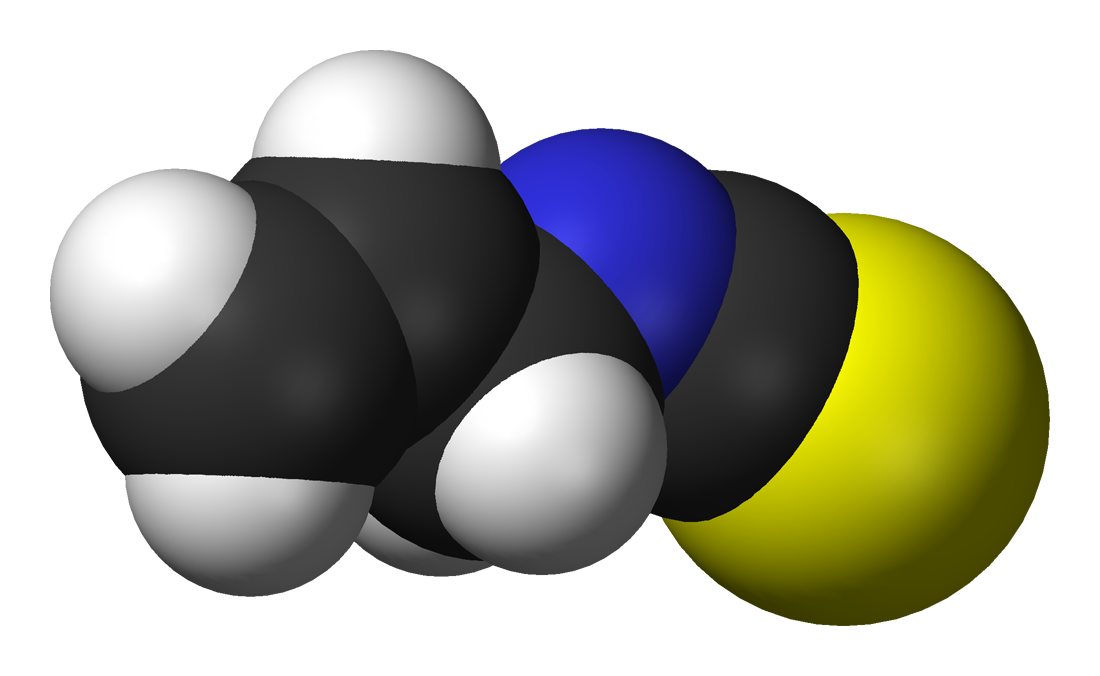Top Qs
Timeline
Chat
Perspective
Allyl isothiocyanate
Chemical compound From Wikipedia, the free encyclopedia
Remove ads
Allyl isothiocyanate (AITC) is a naturally occurring unsaturated isothiocyanate. The colorless oil is responsible for the pungent taste of cruciferous vegetables such as mustard, radish, horseradish, and wasabi. This pungency and the lachrymatory effect of AITC are mediated through the TRPA1 and TRPV1 ion channels.[1][2][3] It is slightly soluble in water, but more soluble in most organic solvents.[4]
Remove ads
Biosynthesis and biological functions
Allyl isothiocyanate can be obtained from the seeds of black mustard (Rhamphospermum nigrum) or brown Indian mustard (Brassica juncea). When these mustard seeds are broken, the enzyme myrosinase is released and acts on a glucosinolate known as sinigrin to give allyl isothiocyanate.[5] This serves the plant as a defense against herbivores; since it is harmful to the plant itself,[6] it is stored in the harmless form of the glucosinolate, separate from the myrosinase enzyme. When an animal chews the plant, the allyl isothiocyanate is released, repelling the animal. Human appreciation of the pungency is learned.[7]: 105
The compound has been shown to strongly repel fire ants (Solenopsis invicta).[8] AITC vapor is also used as an antimicrobial and shelf life extender in food packaging.[7]: 118–120
Remove ads
Production and applications
Allyl isothiocyanate is produced commercially by the reaction of allyl chloride and potassium thiocyanate:[4]
- CH2=CHCH2Cl + KSCN → CH2=CHCH2NCS + KCl
The product obtained in this fashion is sometimes known as synthetic mustard oil. Allyl thiocyanate isomerizes to the isothiocyanate:[9]
- CH2=CHCH2SCN → CH2=CHCH2NCS
Allyl isothiocyanate can also be liberated by dry distillation of the seeds. The product obtained in this fashion is known as volatile oil of mustard.
It is used principally as a flavoring agent in foods. Synthetic allyl isothiocyanate is used as an insecticide, as an anti-mold agent [10] bacteriocide,[11] and nematicide, and is used in certain cases for crop protection.[4] It is also used in fire alarms for the deaf.[12][13]
Hydrolysis of allyl isothiocyanate gives allylamine.[14]
Remove ads
Safety
Allyl isothiocyanate has an LD50 of 151 mg/kg and is a lachrymator (similar to tear gas or mace).[4]
Oncology
Based on in vitro experiments and animal models, allyl isothiocyanate exhibits many of the desirable attributes of a cancer chemopreventive agent.[15]
See also
- Mustard plaster, traditional home remedy
- Piperine, the piquant chemical in black pepper
- Capsaicin, the piquant chemical in chili peppers
- Allicin, the piquant flavor chemical in raw garlic
References
Wikiwand - on
Seamless Wikipedia browsing. On steroids.
Remove ads






